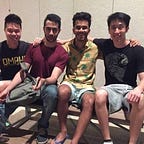100 Million Eyes
Our journey preventing blindness with technology
Growing up in a household of doctors, it wasn’t uncommon for me to see a lot of suffering growing up. My dad happened to run one of the fastest growing diabetes practices in Bangalore, and I had the first hand opportunity to witness the disease’s steep rise among Indians in the 90s. My lack of medical expertise, and my young age, meant that I didn’t understand a lot of what I was seeing at the time. But there was always one thing clear enough to constantly strike a chord with me. Blindness.
One of the most common complications of Diabetes is called ‘Diabetic Retinopathy’ (DR, for short). Diabetic Retinopathy refers to eye damage caused by changes in the glucose levels of the retinal blood vessels. Left unchecked, it causes blindness. 100 million diabetics are currently at risk for the disease, and it happens to be the second leading cause of blindness in India. The catch is, it’s completely preventable.
Well, why don’t doctors prevent it then?
- An abysmally low number of qualified doctors. This is one of the harsh realities of India. Diabetic Retinopathy, being interdisciplinary, requires a trained ophthalmologist to detect it. And for every 10,000 diabetics at risk for the disease, there is only one such doctor qualified enough to detect it, let alone treat it. And that brings me to my second point.
“We told him repeatedly to get his eyes checked, but he never listened to us. And now he needs surgery immediately or he will go blind.”
- Patient non-compliance. The lack of a sufficient number of ophthalmologists results in an extremely high level of inconvenience to a patient. In big cities, this generally implies making a second appointment, travelling for hours in dense traffic and waiting in line before the ophthalmologist can see you. In smaller towns, it involves spending a day travelling to the nearest city, and then all the associated problems mentioned above. DR is asymptomatic, and in today’s world of instant gratification, patients don’t bother with the effort of getting their eyes checked until symptoms start to show.
The solution is technology.
Being in technology gives you the power to do a lot of things. Things such as connecting 2.1 billion people, and educating over 50 million people. Technology makes ambitious targets possible, and enables a future that impacts the lives of millions of people. We want to use the power of technology to end blindness.
This was something my cofounder Florian and I first discussed when we met this July at Entrepreneur First (a startup builder backed by some of the world’s best entrepreneurs and investors). We knew we didn’t want to be yet another tech company solving first world problems, and it wasn’t long before we decided that this was the problem we wanted to solve. With our backgrounds as entrepreneurs and research engineers, we knew that we had the right skills needed to solve the problem.
We began our journey in August, and quickly got to work. We personally visited diabetes hospitals and spoke to over 50 different doctors, and we were able to secure the guidance of some of the most successful people in the industry. We’d love to show everyone our progress thus far, and what’s coming next.
Introducing Medios
Medios is an AI assistant that empowers any doctor, specialist or not, to detect diabetic retinopathy. Using the power of deep learning, we have built a platform that can look at photographs of a human retina and detect the disease.
We believe that our technology can solve both problems mentioned above; we enhance the capability of any doctor to detect the disease, and we improve patient compliance by reducing the number of referrals to a specialist, only done when necessary. By enabling any doctor to detect DR in its earliest stages, we believe we can help prevent vision loss among diabetics.
Here is our website with our working prototype. We currently have a referral accuracy over 90% (tested with a sample size of over 8000 images) and would love to hear what you have to say.
I want to conclude with a few things.
Firstly, we have work left to do, but I promise you we’re on it. This is what we have in the pipeline.
- Improving robustness when dealing with images of poor quality and extraneous noise.
- Fine tuning our algorithm to obtain maximal accuracy irrespective of the camera used to capture the image.
We want everyone to be able to see our progress and we will be updating our prototype online every week.
Secondly, we want to state that we’re working with some of the best diabetes and eye hospitals in building our algorithm, and clinical trials will be conducted. We’re building our platform with a lot of passion and care and we want to ensure that our technology is as accurate as ever.
Thirdly, we need your help. For a goal as ambitious as preventing blindness, we cannot do it alone. We’re glad to hear any feedback you may have to offer, and would love for you to get in touch.
With you, we can make Medios better. Together, we can prevent blindness.
Thanks to everyone who helped us out, in big ways or small. We really really appreciate all the help and couldn’t have built this without you.
